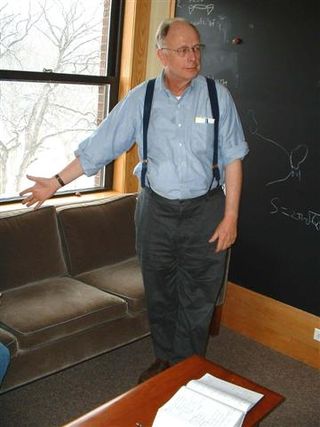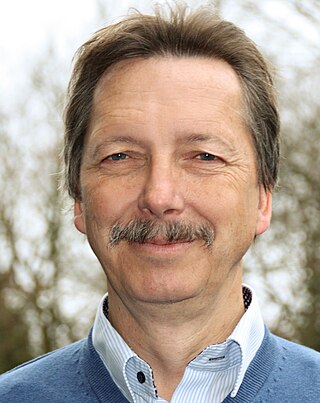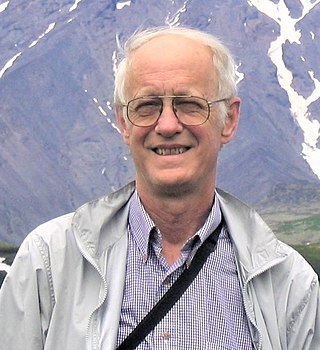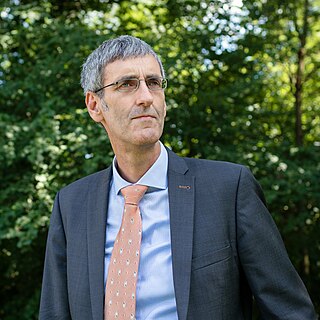Related Research Articles

The Kerr metric or Kerr geometry describes the geometry of empty spacetime around a rotating uncharged axially symmetric black hole with a quasispherical event horizon. The Kerr metric is an exact solution of the Einstein field equations of general relativity; these equations are highly non-linear, which makes exact solutions very difficult to find.
The Max Planck Institute for Extraterrestrial Physics is a Max Planck Institute, located in Garching, near Munich, Germany. In 1991 the Max Planck Institute for Physics and Astrophysics split up into the Max Planck Institute for Extraterrestrial Physics, the Max Planck Institute for Physics and the Max Planck Institute for Astrophysics. The Max Planck Institute for Extraterrestrial Physics was founded as sub-institute in 1963. The scientific activities of the institute are mostly devoted to astrophysics with telescopes orbiting in space. A large amount of the resources are spent for studying black holes in the galaxy and in the remote universe.

James Burkett Hartle is an American physicist. He has been a professor of physics at the University of California, Santa Barbara since 1966, and he is currently a member of the external faculty of the Santa Fe Institute. Hartle is known for his work in general relativity, astrophysics, and interpretation of quantum mechanics.
Eric E. Becklin is an American astrophysicist. The primary focus of Becklin's research is infrared imaging and spectroscopy, including the search for brown dwarfs, the detection of circumstellar dust rings, the dynamics and composition of the center of the Milky Way galaxy, and the nature of luminous infrared galaxies.

The Max Planck Institute for Gravitational Physics is a Max Planck Institute whose research is aimed at investigating Einstein's theory of relativity and beyond: Mathematics, quantum gravity, astrophysical relativity, and gravitational-wave astronomy. The institute was founded in 1995 and is located in the Potsdam Science Park in Golm, Potsdam and in Hannover where it closely collaborates with the Leibniz University Hannover. Both the Potsdam and the Hannover parts of the institute are organized in three research departments and host a number of independent research groups.

In general relativity, a dust solution is a fluid solution, a type of exact solution of the Einstein field equation, in which the gravitational field is produced entirely by the mass, momentum, and stress density of a perfect fluid that has positive mass density but vanishing pressure. Dust solutions are an important special case of fluid solutions in general relativity.
Martin Bojowald is a German physicist who now works on the faculty of the Penn State Physics Department, where he is a member of the Institute for Gravitation and the Cosmos. Prior to joining Penn State he spent several years at the Max Planck Institute for Gravitational Physics in Potsdam, Germany. He works on loop quantum gravity and physical cosmology and is credited with establishing the sub-field of loop quantum cosmology.

Christoph Meinel is a German computer scientist and professor of Internet technologies and systems at the Hasso Plattner Institute (HPI) of the University of Potsdam. He is the scientific director and CEO of the HPI and has developed the openHPI learning platform with more than 1 million enrolled learners. In 2019, he was appointed to the New Internet IPv6 Hall of Fame.

Leibniz Institute for Astrophysics Potsdam (AIP) is a German research institute. It is the successor of the Berlin Observatory founded in 1700 and of the Astrophysical Observatory Potsdam (AOP) founded in 1874. The latter was the world's first observatory to emphasize explicitly the research area of astrophysics. The AIP was founded in 1992, in a re-structuring following the German reunification.

Jürgen Ehlers was a German physicist who contributed to the understanding of Albert Einstein's theory of general relativity. From graduate and postgraduate work in Pascual Jordan's relativity research group at Hamburg University, he held various posts as a lecturer and, later, as a professor before joining the Max Planck Institute for Astrophysics in Munich as a director. In 1995, he became the founding director of the newly created Max Planck Institute for Gravitational Physics in Potsdam, Germany.

Alexey Maksimovich Fridman was a Soviet physicist specializing in astrophysics, physics of gravitating systems and plasma physics. He discovered new types of instabilities in gravitating media, created the theory of planetary rings and predicted the existence of small Uranus satellites that were later discovered. He also developed the hydrodynamic theory of spiral structure in galaxies. Fridman worked at the Institute of Astronomy of the Russian Academy of Sciences, INASAN, and was professor at the Moscow Institute of Physics and Technology and at Moscow State University.

Thomas K. Henning is a German astrophysicist. Since 2001, he is a director at the Max Planck Institute for Astronomy. Henning is an expert in the field of star and planet formation.
Murugesapillai Maheswaran is a mathematician, astrophysicist and educator. He was born in Colombo, Sri Lanka, and emigrated to the United States of America in 1985. Maheswaran has lived in Wausau, Wisconsin since 1986.

Hans-Jürgen Treder was a German theoretical physicist and in the GDR, specializing in general relativity, astrophysics, and cosmology. He also had an interest in the history of science and philosophy.

Luciano Rezzolla is an Italian professor of relativistic astrophysics and numerical relativity at the Goethe University Frankfurt. His main field of study is the physics and astrophysics of compact objects such as black holes and neutron stars. It was announced in 2019 that he had been appointed honorary Andrews Professor of Astronomy at Trinity College Dublin (TCD).
Hans Oleak was a German astrophysicist.

Richard Van Evera Lovelace is an American astrophysicist and plasma physicist. He is best known for the discovery of the period of the pulsar in the Crab Nebula, which helped to prove that pulsars are rotating neutron stars, for developing a magnetic model of astrophysical jets from galaxies, and for developing a model of Rossby waves in accretion disks. He organized a US-Russia collaboration in plasma astrophysics, which focused on modeling of plasma accretion and outflows from magnetized rotating stars.

Frank Eisenhauer is a German astronomer and astrophysicist. He is best known for his contributions to interferometry and spectroscopy and the study of the black hole at the centre of the Milky Way.

Nikolaos Kylafis is a Greek Theoretical Astrophysicist, who is professor emeritus at the Department of Physics of the University of Crete, Greece.
References
- ↑ Neugebauer, G.; Meinel, R. (1993). "The Einsteinian Gravitational Field of the Rigidly Rotating Disk of Dust". The Astrophysical Journal. 414: L97. Bibcode:1993ApJ...414L..97N. doi:10.1086/187005.>